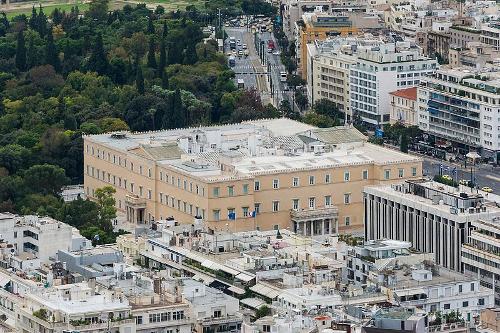PAROS
Society

Society
Popular destinations GREECE
| Aegina | Alonissos | Andros |
| Chios | Corfu | Crete |
| Hydra | Kalymnos | Karpathos |
| Kefalonia | Kos | Lefkas |
| Lesbos | Mykonos | Naxos |
| Paros | Patmos | Peloponnese |
| Poros | Rhodes | Samos |
| Santorini | Skiathos | Skopelos |
| Spetses | Thasos | Zakynthos |
Society
State structure, administrative division and politics
 Greece VouliPhoto: Jebulon in the public domain
Greece VouliPhoto: Jebulon in the public domain
Since 2011, Greece has been divided into 13 administrative regions, known as 'peripheries'. These administrative regions are in turn subdivided into 74 regional units, the 'perifereiaki enotita'. The regional units, which no longer have their own administration, are in turn subdivided into 325 municipalities or 'demoi'. In addition, since 1926, Greece has had one autonomous region under its own Greek Orthodox administration, namely Agion Oros or the monastic state of Athos in Chalkidiki (Northern Greece).
The 13 administrative regions of Greece are Attica (1), Central Greece (2), Central Macedonia (3), Crete (4), Eastern Macedonia and Thrace (5), Epirus (6), Ionian Islands (7), Northern Aegean (8), Peloponnese (9), Southern Aegean (10), Thessaly (11), Western Greece (12) and Western Macedonia (13).
With the administrative reorganisation of 2011, Paros became a regional unit of the administrative region of South Aegean Islands, which further comprises the islands of Andros, Kalymnos, Karpathos, Kea-Kythnos, Kos, Milos, Mykonos, Naxos, Rhodes, Santorini (Thira) Syros and Tinos.
Geographically, Paros belongs to the Central and Eastern Cyclades, which also includes Amorgos, Naxos and Antiparos. Besides the Central and Eastern Cyclades, there are also the Western Cyclades (including Kythnos, Melos and Serifos), the Northern Cyclades (including Andros, Mykonos, Tinos and Syros), the Small Cyclades (including Iraklia, Keros and Donousa) and the Southern Cyclades (including Folegandros, Ios and Santorini). For the current political situation in Greece, see History.
The Marble of Paros
Parian marble is an even finer-grained semi-translucent pure white marble without spots than that of Naxos, quarried during the classical period near the village of Marathi. The marble of Paros is also called "lychnites", from the Greek word "lychnos", meaning oil lamp. The marble was mined by oil lamp light. It is thought that quarrying of the marble stopped as early as the 7th century AD. Only in the 18th and 19th century the mines were (temporarily) reopened, when the first European tourists appeared and the archaeological interest in Greece increased. In 1844, a mine was reopened to supply marble for the crypt in the Dome des Invalides in Paris, where Napeleon Bonaparte's tomb is located.
The Parian marble was highly valued by the ancient Greeks for the creation of sculptures. Some of the greatest masterpieces of ancient Greek sculpture were carved from Parian marble, including the Venus de Milo (The statue is believed to have been made around 130 BC and the sculptor is believed to have been Alexandros of Antiochia), the Medici Venus, a 1st century BC statue of the goddess Aphrodite, and the winged Niké of Samothrake, a statue believed to be from around 200 BC representing the Greek goddess of victory, Niké.
The original stone quarries on Paros, which were used from the 6th century BC onwards, can still be seen on the north side of the island on the slopes of Mount Pantes. Paros' main rival in antiquity was the Pentelic marble of the Pelopponesos, which is also immaculately white, but covered with an even pale yellow tint that causes the marble to glow golden in the sun. The Italian Carrara marble is also spotless white, but with an even vague grey tint. The Parian marble is most similar to the marble of Naxos, which is still quarried near the village of Kinidaros.
Sources
Wikipedia
CIA - World Factbook
BBC - Country Profiles
Last updated December 2025Copyright: Team The World of Info